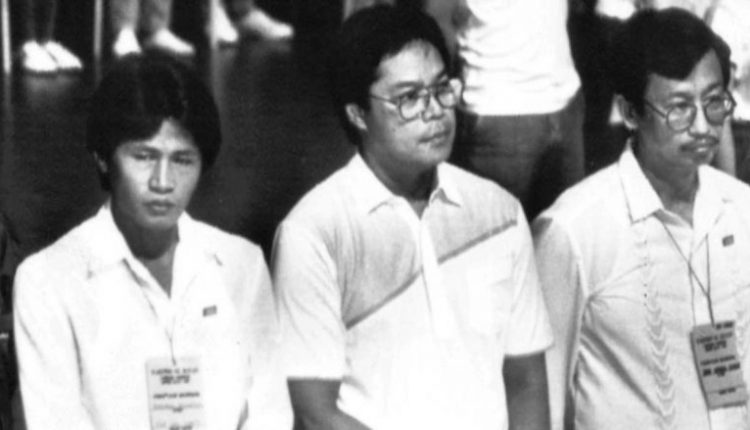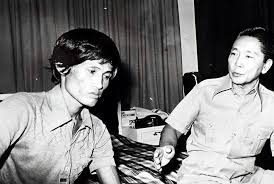Report on the Second Congress of the CPP (Part 2)

An old foto showing Bernabe ‘Kumander Dante’ Buscayno (left) with then Kilusang Mayo Uno chairman, Rolando Olalia and CPP founder, Jose Maria Sison, during the founding Congress of Partido ng Bayan in 1987. Suddenly, the CPP has erased from its official history the role of Buscayno in the formation of the New People’s Army in 1969.
Editor’s Note:
In the first part of this special report Pinoy Exposé published last week, we bared that the CPP’s Second Congress is actually a “coup d’ etat’ for its founder, Jose Maria ‘Joma’ Sison—despite his absence.
Joma’s successful “re-takeover” of the party’s affairs was with the full support, wittingly or unwittingly, of elected party chairman, Julius ‘Ka Nars’ Giron. For all practical purposes, Sison is back as the CPP’s “top boss” and not just the “chief political consultant” in the communists’ peace talks with the government.
The CPP’s Second Congress, held in the hinterlands of Surigao del Sur, came 48 years after its founding congress on December 26, 1968 in Tarlac province. It was attended by “120 delegates” representing “nearly 70,000” party members all over the country, according to communique released four months later by the National Democratic Front of the Philippines.
The date of the Surigao Congress was deliberately chosen; it coincided with the centennial of the 1917 ‘October Revolution’ in Russia that swept into power the Bolshevik Party of Vladimir Lenin, founder of the Soviet Union.
In the first part of this report, we also discussed how Sison is now aiming for the one thing that is dear to the heart of all tyrants: a “cult of personality.”
The drive for a personality cult around him is part of the CPP’s continuing effort to corrupt the minds of the young generations of Filipinos who now comprise the bulk of its recruits, the “cannon fodders” for its “armed struggle.”
Under the theme, ‘Greater Unity, Greater Victory,’ the CPP approved several amendments to its Party Constitution and also adopted a revised a ’10-Point Program’ whose heady banner, ‘Accomplish National Liberation and Pave the Way for a Bright Socialist Future,’ gives all of us a warning on what is going to happen in the event of a CPP victory.
Both documents were among those recovered by government forces in Baguio City last March 13, 2020, from Giron.
Giron and two of his companions were killed after they allegedly resisted the serving of an arrest warrant against him.
In this second installment, we discuss the CPP program. We start by giving a critique of the party’s “version” of world events and Philippine history.
Introduction.
Editor’s Note:
In the first part of this special report Pinoy Exposé published last week, we bared that the CPP’s Second Congress is actually a “coup d’ etat’ for its founder, Jose Maria ‘Joma’ Sison—despite his absence.
Joma’s successful “re-takeover” of the party’s affairs was with the full support, wittingly or unwittingly, of elected party chairman, Julius ‘Ka Nars’ Giron. For all practical purposes, Sison is back as the CPP’s “top boss” and not just the “chief political consultant” in the communists’ peace talks with the government.
The CPP’s Second Congress, held in the hinterlands of Surigao del Sur, came 48 years after its founding congress on December 26, 1968 in Tarlac province. It was attended by “120 delegates” representing “nearly 70,000” party members all over the country, according to communique released four months later by the National Democratic Front of the Philippines.
The date of the Surigao Congress was deliberately chosen; it coincided with the centennial of the 1917 ‘October Revolution’ in Russia that swept into power the Bolshevik Party of Vladimir Lenin, founder of the Soviet Union.
In the first part of this report, we also discussed how Sison is now aiming for the one thing that is dear to the heart of all tyrants: a “cult of personality.”
The drive for a personality cult around him is part of the CPP’s continuing effort to corrupt the minds of the young generations of Filipinos who now comprise the bulk of its recruits, the “cannon fodders” for its “armed struggle.”
Under the theme, ‘Greater Unity, Greater Victory,’ the CPP approved several amendments to its Party Constitution and also adopted a revised a ’10-Point Program’ whose heady banner, ‘Accomplish National Liberation and Pave the Way for a Bright Socialist Future,’ gives all of us a warning on what is going to happen in the event of a CPP victory.
Both documents were among those recovered by government forces in Baguio City last March 13, 2020, from Giron.
Giron and two of his companions were killed after they allegedly resisted the serving of an arrest warrant against him.
In this second installment, we discuss the CPP program. We start by giving a critique of the party’s “version” of world events and Philippine history.
Introduction.
THE four thing that would immediately catch the eyes of any reader who has gone over the 27-page document containing the CPP’s ‘10-Point Program’ are the four things common in all its published articles since its “re-establishment” in 1968:
Consistency in the falsification, simplification and obfuscation of historical facts thru a one-sided view of events thereby resulting to many contradictions;
Deepening Philippine society’s division by emphasizing the role of the working class and the peasants as the main social forces for change;
“Armed struggle” as the only method to be used in order for the party to capture and maintain political power; and,
Self-adulation to convince itself and its members that the CPP is the “leading force” in its self-described “people’s democratic revolution” and in the “remolding” of the Philippines towards “a bright socialist future.”
Taken together, all these things point to the conscious effort by the CPP to revise history to suit its own “world view” and to a single conclusion: the establishment of a CPP dictatorship under the control of one man: Jose Maria Sison (if he lives long enough to see the day NPA forces clowning inside Malacañang after victory).
But to be fair, in only one “basic problem” of the country can Pinoy Exposé, agree with the CPP:
On the overbearing, domineering influence and interference of US Imperialism in our country’s internal and external affairs.
After its successful conquest of the Philippines right after the 1898 Spanish- American War, the Americans have never treated the Philippines and the Filipinos with respect—until Pres. Duterte came along.
A history based on simplification, obfuscation and contradiction
THE first “revision” the CPP made in its “official version” of history is the simplification of its ideological mooring, from ‘Marxism-Leninism-Mao Zedong Thought’ to simply, Marxism-Leninism-Maoism.
But suddenly, the “works” of Lenin’s successor, Josef Stalin and that of Ho Chi Minh, leader of the Vietnamese people in its war of independence against French and American aggressions, “and other great communist thinkers and leaders” are now compulsory for CPP members to be “ceaselessly” studied.
We find this amusing considering that when Joma and his gangmates “reestablished” the party in 1968, among the things he repudiated immediately was the Soviet system (represented by ‘Stalinism’).
Indeed, it was the old, Partido Komunista ng Pilipinas’ (PKP) “loyalty” to the CPSU (Communist Party of the Soviet Union) that Joma used to slander his former party “superiors” (the Lava brothers) as “revisionist renegades” and the old party’s armed wing, the Hukbong Mapagpalaya ng Bayan (HMB/People’s Liberation Army) as a “gangster clique”.
In short, only by savaging Stalinism that Joma succeeded in convincing the younger generation of PKP members to stage a “coup” against their party thru the creation of another, the CPP. But this time, “switching” their “loyalty” from the Soviet Union to Chairman Mao’s ‘Red China.’
The CPP, by way of maintaining its “revolutionary line,” claimed it is always ready to repudiate, among others, manifestations of “subjectivism” and “opportunism of the Right and ‘Left’ varieties.”
But was not the secession of the CPP in 1968 from the PKP and its transfer of allegiance from Stalinism to Maoism a clear show of “opportunism” on a grand scale?
Was this not a case of opportunism of the “Right” and “Left” variety?
Significantly too, in tracing the “victories” of the CPP, absolutely nothing was mentioned about the creation of the New People’s Army on March 29, 1969, some three months after the founding of the CPP.
Suddenly, the name of Bernabe ‘Kumander Dante’ Buscayno, the first “Supremo” of the NPA, was erased from the CPP’s official history, but why?

Kumander Dante with Pres. Ferdinand Marcos after his arrest in 1976
Was it because Buscayno was a member of the ‘Taruc-Sumulong’ branch of the HMB whom Sison had described as a “gangster clique?”
Was it because Buscayno too was part of the “private army” of then Senator Benigno ‘Ninoy’ Aquino, Jr., one of the known “warlords” in Central Luzon?
Or was it because Buscayno “failed” to live the ideal life of a “revolutionary” when he decided to “capitulate” to the government of Pres. Corazon Aquino by deciding to become a farmers’ cooperative leader in their province of Tarlac?
In other words, was the CPP conscious that giving due credit to Buscayno, expounding on its coup against the PKP and by not “glossing over” its earlier “repudiation of Stalinism, “contradictions” would be unmasked?
That questions would be raised by its young generation of recruits leading to doubts and eventually, their decision to leave the party? (end of second part).
https://www.pinoyexpose.net/news/national/the-falsification-simplification-and-obfuscation-of-history

No comments:
Post a Comment
Note: Only a member of this blog may post a comment.